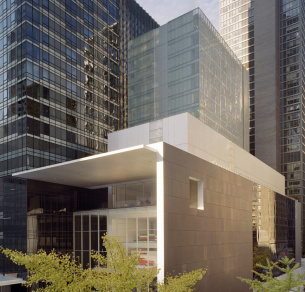The Museum of Modern Art (MoMA), located in New York City, is one of the world’s leading institutions dedicated to modern and contemporary art.
The name “Museum of Modern Art” reflects its focus on modern art, a term broadly encompassing innovative and experimental art movements from the late 19th century to the mid-20th century, and contemporary art, which includes works from the mid-20th century to the present. The acronym MoMA is widely recognized and used globally to refer to the institution.
Established in 1929 by founders Abby Aldrich Rockefeller, Lillie P. Bliss, and Mary Quinn Sullivan.
It was the first museum in the world dedicated exclusively to modern art, aiming to challenge traditional notions of art and showcase groundbreaking works.
MoMA’s mission is to collect, preserve, exhibit, and interpret modern and contemporary art, fostering a deeper understanding of artistic innovation. It seeks to be a dynamic space for education, inspiration, and dialogue about art’s role in society. The museum emphasizes accessibility, diversity, and pushing boundaries in art curation and presentation.
In 1929, MoMA opened its doors in a small rented space in the Heckscher Building, showcasing works by artists like Paul Cézanne, Vincent van Gogh, and Pablo Picasso.
In 1932, moved to a larger space on 53rd Street, designed by architects Philip L. Goodwin and Edward Durell Stone.
In 1939, the museum settled into its current location, with expansions and renovations over the decades to accommodate its growing collection and visitor numbers.
In 2004, a major renovation by architect Yoshio Taniguchi expanded the museum, adding more gallery space and modern facilities.
In 2019, another significant renovation, led by Diller Scofidio + Renfro, increased gallery space by 30%, improved accessibility, and introduced flexible, interdisciplinary exhibition spaces to better showcase contemporary art and diverse voices.
MoMA has evolved from a niche institution to a global cultural landmark, adapting to changes in art, society, and technology while maintaining its commitment to innovation.
MoMA houses one of the most significant collections of modern and contemporary art in the world, with over 200,000 works across various mediums. Its collection is divided into several curatorial departments:
Painting and Sculpture:
Iconic works by artists such as Vincent van Gogh (The Starry Night, 1889), Pablo Picasso (Les Demoiselles d’Avignon, 1907), Claude Monet (Water Lilies, 1914–26), and Jackson Pollock (One: Number 31, 1950).
Features movements like Impressionism, Cubism, Surrealism, Abstract Expressionism, and Minimalism.
Drawing and Prints:
Extensive collection of works on paper, including drawings, prints, and illustrated books by artists like Henri Matisse, Andy Warhol, and Käthe Kollwitz.
Photography:
Pioneering collection started in 1930, with works by photographers like Ansel Adams, Diane Arbus, and Cindy Sherman.
Architecture and Design:
Includes architectural models, furniture, and everyday objects, such as the Eames chair and the Vespa scooter, highlighting the intersection of art and functionality.
Film:
Over 30,000 films and media works, ranging from early silent films to contemporary video art, including works by Charlie Chaplin, Alfred Hitchcock, and experimental filmmakers.
Media and Performance:
Showcases time-based and live art, including video installations and performance documentation by artists like Yoko Ono and Marina Abramović.
MoMA’s collection is constantly growing, with an emphasis on acquiring works by underrepresented artists, including women, artists of color, and those from non-Western regions, to reflect a more inclusive history of modern art.
Exhibitions and Programmes
Permanent Collection Displays: MoMA’s galleries are organized to highlight the evolution of modern art, with thematic and chronological presentations.
Temporary Exhibitions: The museum hosts rotating exhibitions featuring individual artists, movements, or themes, such as retrospectives of Yayoi Kusama or Jean-Michel Basquiat.
MoMA PS1: Located in Long Island City, Queens, MoMA PS1 focuses on experimental and contemporary art, hosting innovative exhibitions, performances, and events like the Warm Up summer music series.
Educational Programmes: MoMA offers lectures, workshops, online courses, and family-friendly activities to engage diverse audiences.
Film Screenings: The museum’s film department hosts regular screenings, festivals, and retrospectives in its state-of-the-art theaters.
Cultural Significance
Global Influence: MoMA has shaped the canon of modern art, defining which artists and movements are considered pivotal. Its curatorial decisions have historically influenced art markets and scholarship.
Innovation: The museum pioneered the inclusion of photography, film, and design as legitimate art forms, expanding the definition of “art.”
Accessibility: MoMA strives to make art accessible through free admission programs, online resources (like MoMA’s extensive digital archive), and multilingual materials.
Criticism and Evolution: While MoMA has been criticized for its historically Eurocentric and male-dominated focus, recent efforts prioritize diversity, equity, and inclusion, showcasing works by underrepresented artists and rethinking how art history is presented.
Visitor Information
Hours: Open daily, typically 10:30 AM–5:30 PM, with extended hours on Fridays.
Admission:
General admission is around $25 for adults, with discounts for students, seniors, and children under 16 (free).
Free admission for NYC residents on the first Friday of each month (after 4:00 PM).
Memberships offer unlimited free entry and other perks.
Accessibility: Fully wheelchair-accessible, with accommodations for sensory and cognitive needs.
Amenities: Includes a bookstore, gift shop, cafes, and restaurants like The Modern, a Michelin-starred dining option.
MoMA’s Broader Meaning
The “meaning” of MoMA extends beyond its physical collection or exhibitions. It represents:
A Space for Innovation: MoMA challenges conventional ideas about art, encouraging creativity and critical thinking.
A Cultural Beacon: It serves as a global destination for understanding the artistic achievements of the modern era.
A Platform for Dialogue: Through its exhibitions and programs, MoMA fosters conversations about identity, politics, technology, and the human experience.
Constantly evolving, MoMA reflects the changing landscape of art and society, striving to remain relevant in a rapidly shifting world.
Address: 11 West 53rd Street, New York, NY 10019, with an additional location, MoMA PS1, in Queens, NY. MoMA is situated in Midtown Manhattan, making it a central hub for art lovers and tourists.
© Preems

